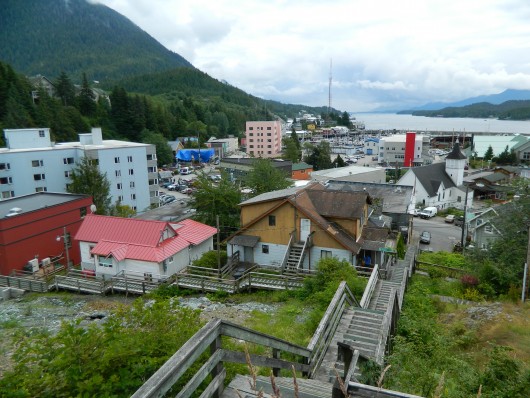The Ketchikan City Council agreed Thursday to accept a compliance order from the state Department of Environmental Conservation over the city’s ongoing water issues.
City officials had input into the order, which is a legal document that spells out what the city must do over the next couple of years to get city water into compliance with federal regulations.
The city has two big problems it needs to fix. The first is that Ketchikan Lakes, which is the source of the city’s drinking water, has higher-than-allowed levels of coliform bacteria. The water is disinfected before it’s distributed, but the federal Environmental Protection Agency still regulates coliform levels in the source water.
That problem is compounded by increased instances of turbidity, which is when the water is churned up, usually by storms.
The city has started investigating the coliform problem, said City Manager Karl Amylon, and the order allows that study to continue.
“What the compliance order by consent does is, it allows for an additional two-year period for us to do further review and testing in order to try and determine what’s going on relative to coliform and turbidity, and how we can get our arms around it,” he said.
Floyd Damron of engineering consulting firm CH2M-Hill spoke about ongoing testing that his firm was hired to do for the city. He said they are about mid-way through that study, which is looking at coliform sources, and potential ways to reduce coliform at the intake sites.
Damron said he can’t promise that the end result will allow the city to continue avoiding filtration, but that is the goal.
“That’s the hope, that we can find either by taking a water source offline during storm events, or by potentially taking water from a deeper portion of the lake, that it may help improve water quality,” he said. “But until those are advanced and more data is collected, we won’t know the results. But the nice thing of the (compliance order) is, it buys you two more years.”
The second problem with the city’s water is high levels of regulated byproducts, which are created when organic material comes into contact with chlorine disinfection.
The city’s water has exceeded allowed levels for those byproducts for a while, and the city built a new water treatment system to address that problem. The new system uses chloramine — a combination of chlorine and ammonia — plus a dose of ultraviolet radiation.
The byproduct levels did drop, but not enough. The city now is working on a tweak for that new system, which will reduce the initial chlorine even more, and then add chlorine again later, after the water has gone through the rest of the treatment system.
The entire compliance order is expected to cost the city between $1.75 and $2.25 million. The bulk of that cost is the new two-point chlorination treatment system, estimated to cost between $1.3 and $1.7 million.
Damron said the money won’t be wasted, even if the city eventually has to go to filtration.
“If you ever did have to build a filter plant, this second chlorination facility would remain in service and remain useful to you,” he said. “It would become then, your primary disinfection point.”
The city wants to avoid building a filtration plant because it would be very expensive to build and operate. However, if the water issues can’t be resolved, state and federal officials could force the city to take that step.
Also Thursday, the Council approved a contract with Rite Way Roofing of Anchorage to replace the Centennial Building roof; and approved a contract with PND Engineers to finish design work on the Thomas Basin Seawall project. The next Council meeting is a special budget meeting, scheduled for 7 p.m. Monday in City Council chambers.






